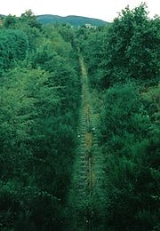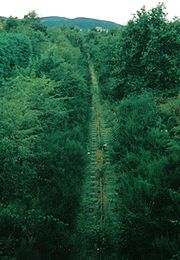
Castle Douglas and Dumfries Railway
Encyclopedia

Dumfries
Dumfries is a market town and former royal burgh within the Dumfries and Galloway council area of Scotland. It is near the mouth of the River Nith into the Solway Firth. Dumfries was the county town of the former county of Dumfriesshire. Dumfries is nicknamed Queen of the South...
to Castle Douglas
Castle Douglas
Castle Douglas , a town in the south of Scotland in Dumfries and Galloway, lies in the eastern part of Galloway known as the Stewartry, between the towns of Dalbeattie and Gatehouse of Fleet.-History:...
.
History
It was incorporated on 21 July 1856; the act was obtained by the Glasgow and South Western RailwayGlasgow and South Western Railway
The Glasgow and South Western Railway , one of the pre-grouping railway companies, served a triangular area of south-west Scotland, between Glasgow, Stranraer and Carlisle...
.
It opened on 7 November 1859 and was substantially closed, under the Beeching Axe
Beeching Axe
The Beeching Axe or the Beeching Cuts are informal names for the British Government's attempt in the 1960s to reduce the cost of running British Railways, the nationalised railway system in the United Kingdom. The name is that of the main author of The Reshaping of British Railways, Dr Richard...
, on 14 June 1965. The section between Maxwellton and Dumfries remained open to serve an oil depot. The line is now mothballed.
In 1861 the Portpatrick Railway
Portpatrick Railway
The Portpatrick and Wigtownshire Joint Railway, often known as the Port Road, was a railway in south-west Scotland, which linked Dumfries, via Castle Douglas, with the port towns of Portpatrick and Stranraer...
completed a connection from Castle Douglas to Portpatrick
Portpatrick
Portpatrick is a village hanging on to the extreme south-westerly tip of mainland Scotland, cut into a cleft in steep cliffs.Dating back historically some 500 years, and built adjacent to the ruins of nearby Dunskey Castle, its position on the Rhins of Galloway affords visitors views of the...
and Stranraer
Stranraer
Stranraer is a town in the southwest of Scotland. It lies in the west of Dumfries and Galloway and in the county of Wigtownshire.Stranraer lies on the shores of Loch Ryan on the northern side of the isthmus joining the Rhins of Galloway to the mainland...
.
The Castle Douglas and Dumfries Railway was acquired by the Glasgow and South Western Railway on 1 August 1865 - this was itself acquired by the London, Midland and Scottish Railway
London, Midland and Scottish Railway
The London Midland and Scottish Railway was a British railway company. It was formed on 1 January 1923 under the Railways Act of 1921, which required the grouping of over 120 separate railway companies into just four...
in the 1923 grouping of the railways
Railways Act 1921
The Railways Act 1921, also known as the Grouping Act, was an enactment by the British government of David Lloyd George intended to stem the losses being made by many of the country's 120 railway companies, move the railways away from internal competition, and to retain some of the benefits which...
.
The Caledonian Railway
Caledonian Railway
The Caledonian Railway was a major Scottish railway company. It was formed in the early 19th century and it was absorbed almost a century later into the London, Midland and Scottish Railway, in the 1923 railway grouping, by means of the Railways Act 1921...
gained running rights
Arrangements between railroads
Railway companies can interact with and control others in many ways. These relationships can be complicated by bankruptcies.-Operating:Often, when a railroad first opens, it is only a short spur of a main line. The owner of the spur line may contract with the owner of the main line for operation of...
over the line between Dumfries and Castle Douglas; which allowed it access to Portpatrick, Stranraer and Stranraer harbour over a jointly owned line, the Portpatrick and Wigtownshire Joint Railway. These running rights allowed the Caledonian Railway to run Irish boat trains from Carlisle and south of the border without having to go though Ayrshire.
Connections to other lines
- Glasgow, Dumfries and Carlisle RailwayGlasgow, Dumfries and Carlisle RailwayThe Glasgow, Dumfries and Carlisle Railway was a company in Scotland, which built and ran what is now known as the Glasgow South Western Line. The line was authorised on 13 August 1846 and was constructed between 1846 and 1850...
at Dumfries. - The Dumfries, Lochmaben & Lockerby (sic) Railway at Dumfries.
- Kirkcudbright Railway at Castle Douglas.
- Portpatrick RailwayPortpatrick RailwayThe Portpatrick and Wigtownshire Joint Railway, often known as the Port Road, was a railway in south-west Scotland, which linked Dumfries, via Castle Douglas, with the port towns of Portpatrick and Stranraer...
at Castle Douglas.
Sources
- RAILSCOT on Castle Douglas and Dumfries Railway
- The Introduction of the Railway into Galloway Fifty Years Ago from The Gallovidian (1909)

